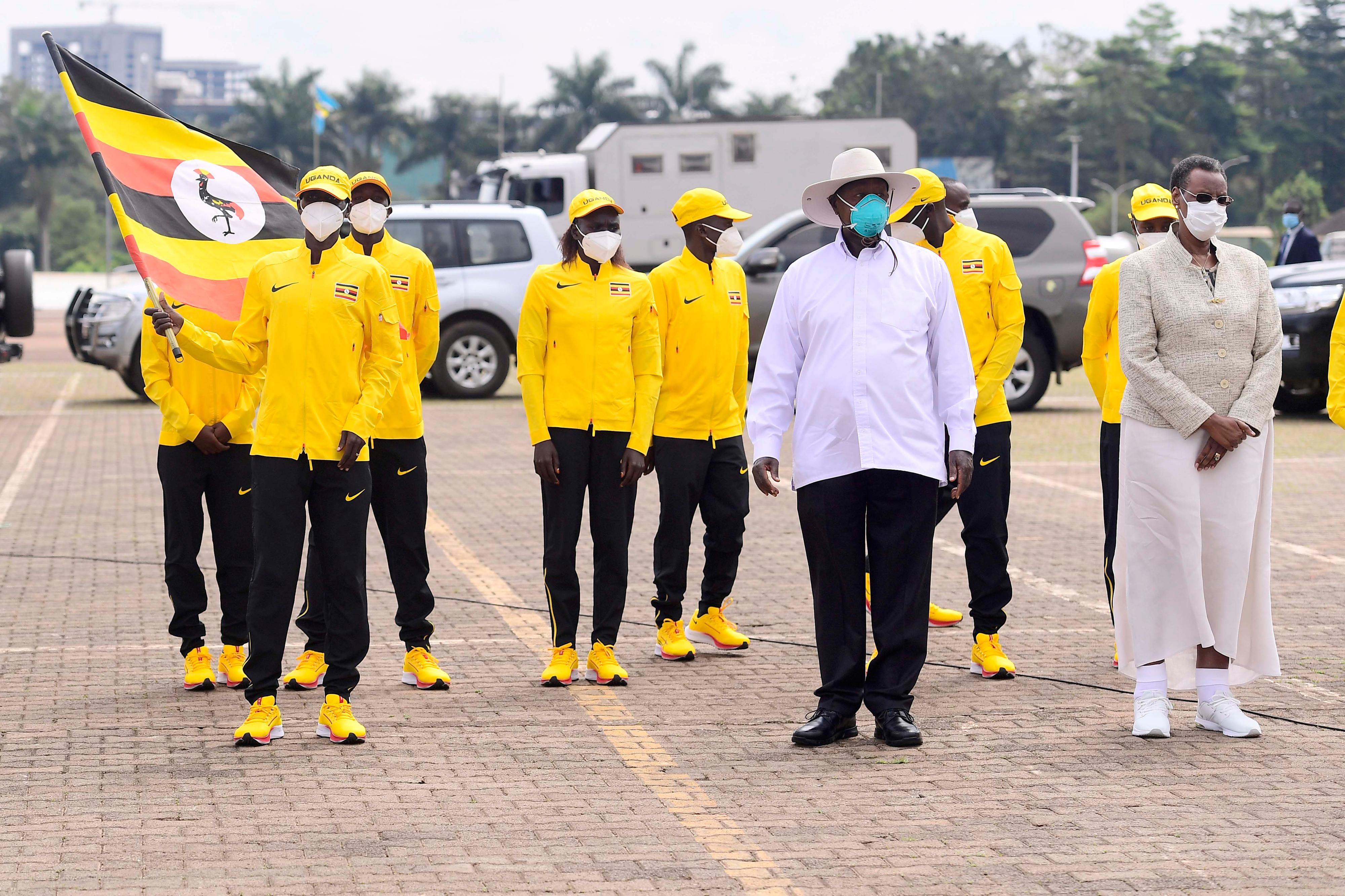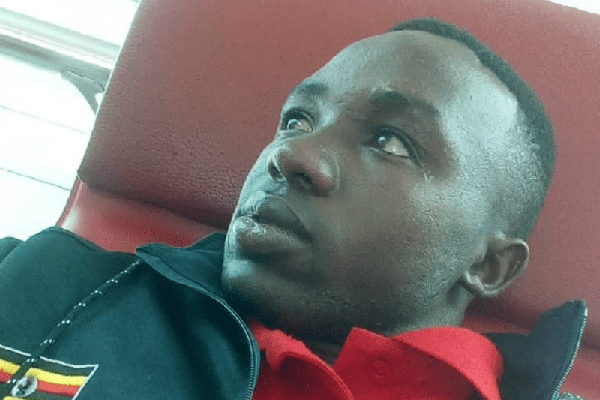Why Uganda is sending more officials than athletes to Tokyo

President Museveni and First Lady Janet flag off the Uganda Olympics Team to Japan at Kololo Independence Grounds on July 9. PHOTO/PPU
What you need to know:
The number of PTOS is determined by the sum of the following three calculations:
• One (1) team official for each discipline in which male athletes have been duly entered (maximum 44)
• One (1) team official for each discipline in which female athletes have been duly entered (maximum 46)
• The number of team officials corresponding to the total number of individual athletes duly entered as below.
One of the stories that always accompanies Uganda’s Olympic team is the competing numbers of athletes versus officials.
Ugandans are often left wondering why officials almost match athletes in numbers, or sometimes beat them.
The situation is worsened by allegations of some officials carrying along relatives and close associates instead of investing more in the team, as was reported at the 2014 Glasgow Commonwealth Games, among others.
Uganda is sending a 56-member contingent to Tokyo Olympics this time, 25 of them athletes competing in four disciplines- the most since 1984 Los Angeles edition.
At 13, female athletes beat men for the first time, and also makes it their biggest representation at the Games - ever.
The rest of the travelling contingent - 31 to be precise - include coaches, general officials, administrators and government officials.
Coaches are 12, National Olympic Committee (NOC) members - including president Don Rukare are four, and two International Technical Officials (ITOs).
The ITOs are travelling as games officials at the invitation of their respective international federations and the IOC (for boxing, since Aiba was given a red flag).
The Ugandan delegation is led by State Minister for Sports Denis Hamson Obua. Other officials include IOC member William Blick, Beatrice Ayikoru (Chef De Mission) and National Council of Sports (NCS) general secretary Bernard Patrick Ogwel (general team manager).
Ms Jacqueline Nana Nakiddu travels as a team doctor, Ms Prossy Namusisi and Mr Tom Oomen as physiotherapists, while Ms Shadiah Nakamanya is the chaperone.
A media liaison officer, two team administrators and an athletes representative complete the 31-man officials list.
Officials vs determinants
But how is the athletes versus officials quota arrived at? “There is an IOC ratio multiplier that helps determine the athletes versus officials numbers, but there are also officials that will be at the Games regardless,” Mr Rukare says.
“IOC members, for example, and NOC, plus high government dignitaries are always guests of the IOC, even if we qualified only one athlete. And as NOC, you are also entitled to an accompanying guest of your choice.
“And you, the inviter, pays the air ticket fare for your guest but your guest is not entitled to government allowances. They are only entitled to accomodation and accreditation.”
However, the guest programme was scrapped off as a measure to contain Coronavirus.
Mr Rukare admits that while IOC/NOC senior members like himself travel on invitation of the Olympic body, they are also part of the Ugandan delegation as the national sports heads, and are, therefore, facilitated in allowances by both.
Back to athletes versus officials, the number of primary team officials (PTOs) at the Olympics is determined by the sum of the following calculations.
For every 1-4 duly entered male athletes in each discipline - maximum being 44, there will be one official. The same is true if the entered athletes are female, maximum being 46.
The number of team officials must be corresponding to the total number of individual athletes duly entered.
The quota system is, however, silent on specificity. It does not specify whether the official should be technical or general.
If we are to go with technical, Uganda falls into the 25-29 category, and for these numbers, UOC is carrying 12 officials. This is outside of medical and general officials.
But even then, some gender requirements fall short. For example, athletics trainer Margaret Ijala is the only female coach despite 13 ladies competing in four disciplines. However, that can be explained in who a particular athlete has been working with in the run-up.
“Resources permitting, we would have had a female official for every discipline,” Mr Rukare says.
Then there is the matter of boxing, which has three boxers, including a lady, in Tokyo.
As per Uganda’s boxing president Moses Muhangi, submissions National Council of Sports (NCS) general secretary Ogwel and Mr Rukare agree with but contend it can only be reviewed for the future, the IOC ratio system is flawed.
While at two technical officials - Aiba 1 star coach Patrick Lihenda and Hassan Mohammed Mulandi - boxing is sorted within the quota, the technical needs of the game are not fulfilled.
“A boxer has three officials with him by the corner side during competition, that’s the standard,” Mr Muhangi says.
“Each of these officials,” he adds, “and not necessarily coaches, has a role to play.
“Official number one must be an Aiba certified coach with minimum 1 star. He is the one that is authorised to enter the ring during fight break.
“This is the main official, who analyses the fight and is able to advise the competing boxer on what to do to win the fight.”
The second official, a minimum 1 star, normally has a towel, water, and is responsible for picking and washing the mouth guard in case it drops in the ring during fight.
He also throws in the towel when necessary.
The third official, called a cut technician, manages the spit-can and stitches minor injuries on the boxer’s face during competition.
“So this is the standard in boxing,” asserts Mr Muhangi, “that’s the team that a boxer requires while in competition, this is a sign of well preparedness of a boxer.
“And the performance of the boxer is majorly dependent on this team work between the competing boxer and coaches/officials/seconds in his or her corner!”
Mr Muhangi’s argument is that boxing should have had at least an extra official - technical or general - and from engagements on different forums, that official could have been a federation head.
But Mr Rukare says while Mr Muhangi raises valid points, he (Muhangi) was not in the initial long list submitted almost a year before the Games.
“That is the list all federations first submit with athletes they think stand higher chances of qualifying and potential officials or coaches to go along with them. Muhangi was not on that list, and the two coaches that finally made it are from the lost that the boxing federation gave us.
“Resources permitting, we would have taken all submitted. There have also been calls to have federation heads travel for the Games to learn.
“Maybe that can be reviewed in policy for the future but not for Tokyo.”
Asked why Team Uganda has two administrators under the general team manager, Mr Ogwel says:“The administrative team has a lot of runnings to do before, during and after the Games - from the team well being, clothing and all.”
Mr Ogwel did not rule out more numbers from government travelling even though they are not on the official 56-man contingent.
“Principals of government including accounting officers, politicians, the people who take decisions before, during and after games will be there as government dignitaries resources permitting.
“And their allowances will be paid to them according to their senior level per diem guidelines.
“But what I can tell you is that on our list, all athletes, officials (technical and non) and administrators are being paid a basic $2,000 (about Shs7.1m) after accomodation and other basic expenses are taken care of.
Regarding the two ITOs (one more for Paralympics) that are travelling for official duty, he says: “We are not paying for their air tickets or accomodation. That is taken care of by their international federations and IOC.”
Mr Ogwel adds: “But we treat them as part of us as Ugandans, and give them our official clothing, cultural wear and even allowances.”
He also says they paid federations for qualifying periods, and cleared at least $80 (about Shs284,000) per day to athletes and officials during qualifying races, in addition to cost-sharing with Japan for pre -Game camps in two cities.
Uganda Olympics team
Athletes
Esther Chebet, Sarah Chelangat, Albert Chemutai, Prisca Chesang, Ronald Musagala, Winnie Nanyondo, Halima Nakaayi, Joshua Cheptegei, Jacob Kiplimo, Oscar Chelimo, Stephen Kissa, Peruth Chemutai, Mercyline Chelangat, Immaculate Chemutai, Juliet Chekwel, Stephen Kiprotich, Filex Chemongesi, Fred Musobo, Shida Leni
Boxing
Catherine Nanziri, Musa Shadir Bwogi, David Kavuma Ssemujju
Rowing
Grace Kathleen Noble
Swimming
Kirabo Namutebi, Ambala Atuhaire
General officials
Denis Hamson Obua (head of delegation), William Blick (IOC Member), Dr Donald Rukare (President NOC), Beatrice Ayikoru (Chef De Mission), Dr. Bernard Patrick Ogwel (General Team manager), Dr Jacqueline Nana Nakiddu (Team doctor), Prossy Namusisi (Physiotherapist), Tom Oomen (Physiotherapist), Shadiah Nakamanya (Chaperone), Aisha Nassanga (Media Liaison), Elijah Njawuzi (Team Admin), Ivan Mugowa (Team Admin), Moses Mwase (NOC), Ganzi Mugula (Athletes Representative)
Technical officials
Adrianus Ruiter (Coach, Athletics – Tokyo), Faustino Kiwa (Coach, Athletics – Sapporo), Gordon Ahimbisibwe (Coach, Athletics – Sapporo), Domenic Otucet (Official – Athletics, Tokyo), Margaret Ijala (Coach – Athletics, Tokyo), Narisesio Bigingo (Coach – Athletics, Tokyo), Benjamin Njia (Coach – Athletics, Tokyo), Andrew Sorowen (Official – Athletics, Tokyo), Patrick Lihenda (Coach, Boxing), Hassan Mohammed Mulandi (Coach, Boxing), Rodrick Muhumuza (Coach, Rowing), Ahsan Iqbal (Coach, Rowing), Muzafaru Muwanguzi (Coach, Swimming), Dunstan Nsubuga (NOC), Sadik Nasiwu (NOC), Salim Ssenkungu Musoke (ITO, Weightlifting), Aciga Fula (ITO, Boxing)
PRIMARY TEAM OFFICIALS (ptoS)
The number of PTOS is determined by the sum of the following three calculations:
• One (1) team official for each discipline in which male athletes have been duly entered (maximum 44)
• One (1) team official for each discipline in which female athletes have been duly entered (maximum 46)
• The number of team officials corresponding to the total number of individual athletes duly entered as below.
Athletes PTOs
1-4 1
5-9 3
10-14 5
15-19 8
20-24 10
25-29 12
30-34 14
35-39 16
140-144 40
145-149 41
150-154 42
155-159 43
160-164 44
165-169 45
170-174 46
175-179 47
Atheletes PTOs
295-299 71
300-305 72
306-310 73
311-315 74
316-320 75
321-325 76
326-330 77
331-335 78
451-455 102
456-460 103
461-465 104
466-470 105
471-475 106
476-480 107
481-485 108
486-490 109




